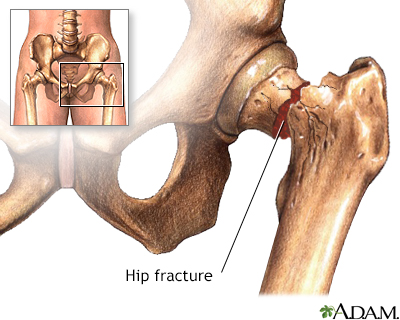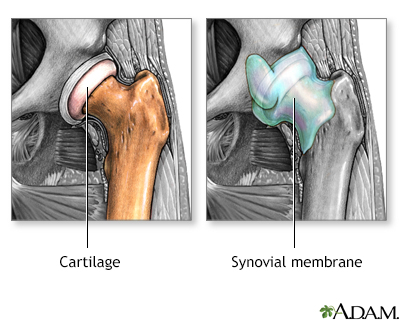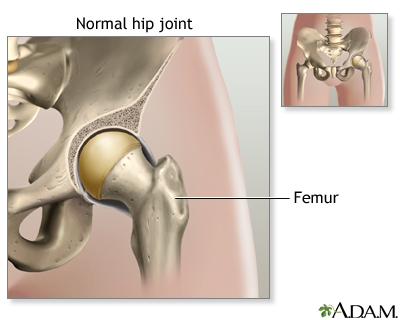Hip joint replacement
Hip arthroplasty; Total hip replacement; Hip hemiarthroplasty; Arthritis - hip replacement; Osteoarthritis - hip replacement
Hip joint replacement is surgery to replace all or part of the hip joint with a man-made joint. The artificial joint is called a prosthesis.

Hip fractures occur as a result of major or minor trauma. In elderly patients with bones weakened by osteoporosis, relatively little trauma, even walking, may result in a hip fracture.

Osteoarthritis is a deterioration of cartilage and overgrowth of bone often due to wear and tear. Rheumatoid arthritis is the inflammation of a joint's connective tissues, such as the synovial membranes, which leads to the destruction of the articular cartilage.

The hip joint is made up of two major parts the hip socket (a part of the pelvic bone called the acetabulum) and the beginning part of the thighbone (called the femur).
Your hip is hurting so bad, you can't sleep. It's hard to bathe, to clean, make it to the mailbox or shop at the mall. You may have severe arthritis in your hip, and there's a good chance you need a hip replacement. Hip replacements are usually done in people age 60 and older. If you need one, you probably have severe arthritis that limits your daily life, or perhaps have a hip fracture. Your hip joint is made up of two parts, the hip socket and the upper end of the thigh bone. One or both parts may be replaced during surgery. Your new hip will probably have a socket made of strong metal, a liner that fits inside the socket, usually plastic, a metal or ceramic ball to replace the round head of your thigh bone, and a metal stem attached to the thigh bone to make your joint more stable. So, how is the hip replacement procedure done? Well you won't not feel any pain during surgery because you will have medicine to make you fall asleep. The surgeon will cut and remove the head of your thigh bone and clean out your hip socket, removing cartilage and damaged or arthritic bone. The surgeon will put the new hip socket in place, insert the metal stem into your thigh bone, and place the ball for a new joint. Cement will probably hold the new joint in place. The surgery can take several hours. After the surgery, you will probably stay in the hospital for three to five days. As soon as the first day after surgery, you will be asked to start moving and walking around with a walker, crutches, or a cane. You will need physical therapy to strengthen your new joint for up to several weeks after your operation. Some people need a short stay in a rehabilitation center after they leave the hospital. At the rehab center, you will learn how to safely do your daily activities on your own. Your new hip should allow you to resume your daily activities once you've learned to move around on your own. In the long run, over 20 years or so, the joint may need to be placed again. But, in the short run, most or all of your pain should go away. The stiffness should go away. Your doctor should be able to monitor any problems and you should enjoy your new joint.
Description
Your hip joint is made up of 2 major parts. One or both parts may be replaced during surgery:
- The hip socket (a part of the pelvic bone called the acetabulum)
- The upper end of the thighbone (called the femoral head)
The new hip that replaces the old one is made up of these parts:
- A socket, which is usually made of strong metal.
- A liner, which fits inside the socket. It is most often plastic. Some surgeons are now trying other materials, such as ceramic or metal. The liner allows the hip to move smoothly.
- A metal or ceramic ball that will replace the round head (top) of your thigh bone.
- A metal stem that is attached to the thigh bone to anchor the joint.
You will not feel any pain during surgery. You will have one of the following types of anesthesia:
- General anesthesia -- This means you will be asleep and unable to feel pain.
- Regional (spinal or epidural) anesthesia -- Medicine is put into your back to make you numb below your waist. You will also get medicine to make you sleepy. And you may get medicine that will make you forget about the procedure, even though you will not be fully asleep.
After you receive anesthesia, your surgeon will make a surgical cut to open up your hip joint. This cut is often over the buttocks or the side of your hip. Then your surgeon will:
- Cut and remove the head of your thigh bone.
- Clean out your hip socket and remove the rest of the cartilage and damaged or arthritic bone.
- Put the new hip socket in place; a liner is then placed in the new socket.
- Insert the metal stem into your thigh bone.
- Place the correct-sized ball for the new joint.
- Secure all of the new parts in place, sometimes with a special cement.
- Repair the muscles and tendons around the new joint.
- Close the surgical wound.
This surgery takes about 1 to 3 hours.
Why the Procedure Is Performed
The most common reason to have this surgery is to relieve arthritis. Severe arthritis pain can limit your activities.
Most of the time, hip joint replacement is done in people age 60 and older. Many people who have this surgery are younger. Younger people who have a hip replaced may put extra stress on the artificial hip. That extra stress can cause it to wear out earlier than in older people. Part or all of the joint may need to be replaced again if that happens.
Your health care provider may recommend a hip replacement for these problems:
- You can't sleep through the night because of hip pain.
- Your hip pain has not gotten better with other treatments.
- Hip pain limits or prevents you from doing your normal activities, such as bathing, preparing meals, doing household chores, and walking.
- You have problems walking that require you to use a cane or walker.
Other reasons for replacing the hip joint are:
- Fractures in the thigh bone. Older adults often have a hip replacement for this reason.
- Hip joint tumors.
Before the Procedure
Always tell your provider what medicines you are taking, even medicine, supplements, or herbs you bought without a prescription. Your provider may also want you to lose weight prior to having surgery.
During the 2 weeks before your surgery:
- Prepare your home to make everyday tasks easier.
- You may be asked to stop taking medicines that make it harder for your blood to clot. These include aspirin, ibuprofen (Advil, Motrin), naproxen (Naprosyn, Aleve), blood thinners such as warfarin (Coumadin), and other medicines.
- You may also need to stop taking medicine that can make you more likely to get an infection. This includes methotrexate, Enbrel, and other medicines that suppress your immune system.
- Ask your surgeon which medicines you should still take on the day of your surgery.
- If you have diabetes, heart disease, or other medical conditions, your surgeon will ask you to see the provider who treats you for these conditions.
- Tell your surgeon if you have been drinking a lot of alcohol, more than 1 or 2 drinks a day.
- If you smoke, you need to stop. Ask your provider or nurse for help. Smoking will slow down wound and bone healing. It has been shown that smokers have worse outcomes after surgery.
- Always let your surgeon know about any cold, flu, fever, herpes breakout, or other illness you have before your surgery.
- You may want to visit a physical therapist to learn some exercises to do before surgery and to practice using crutches or a walker.
- Ask your surgeon to see whether you need to go to a nursing home or rehabilitation facility after surgery. If you do, you should check out these places ahead of time and note your preference.
Practice using a cane, walker, crutches, or wheelchair correctly to:
- Get in and out of the shower
- Go up and down stairs
- Sit down to use the toilet and stand up after using the toilet
- Use the shower chair
On the day of your surgery:
- You will usually be asked not to drink or eat anything for 6 to 12 hours before the procedure.
- Take the medicines your surgeon told you to take with a small sip of water.
Your surgeon will tell you when to arrive at the hospital.
After the Procedure
You will stay in the hospital for 1 to 3 days. During that time, you will recover from your anesthesia and from the surgery itself. You will be asked to start moving and walking as soon as the first day after surgery.
Some people need a short stay in a rehabilitation center after they leave the hospital and before they go home. At a rehab center, you will learn how to safely do your daily activities on your own. Home health services are also available.
Outlook (Prognosis)
Hip replacement surgery results are very often excellent. Most or all of your pain and stiffness should go away.
Some people may have problems with infection, loosening, or even dislocation of the new hip joint.
Over time, the artificial hip joint can loosen. This can happen after as long as 15 to 20 years. You may need a second replacement. An infection can also occur. You should check with your surgeon periodically to ensure your hip is in good condition.
Younger, more active people may wear out parts of their new hip. It may need to be replaced before the artificial hip loosens.
References
American Academy of Orthopaedic Surgeons website. OrthoInfo. Treatment: total hip replacement.
Ferguson RJ, Palmer AJ, Taylor A, Porter ML, Malchau H, Glyn-Jones S. Hip replacement. Lancet. 2018;392(10158):1662-1671. PMID: 30496081
Harkess JW, Crockarell JR. Arthroplasty of the hip. In: Azar FM, Beaty JH, eds. Campbell's Operative Orthopaedics. 14th ed. Philadelphia, PA: Elsevier; 2021:chap 3.
Rizzo TD. Total hip replacement. In: Frontera WR, Silver JK, Rizzo TD Jr, eds. Essentials of Physical Medicine and Rehabilitation. 4th ed. Philadelphia, PA: Elsevier; 2019:chap 61.
Version Info
Last reviewed on: 8/12/2023
Reviewed by: C. Benjamin Ma, MD, Professor, Chief, Sports Medicine and Shoulder Service, UCSF Department of Orthopaedic Surgery, San Francisco, CA. Also reviewed by David C. Dugdale, MD, Medical Director, Brenda Conaway, Editorial Director, and the A.D.A.M. Editorial team.
